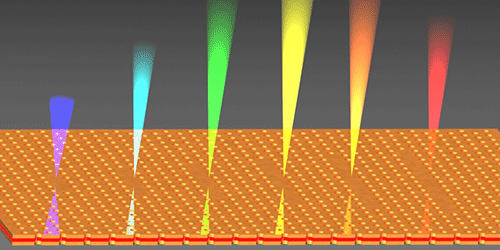Not Too Short, Not Too Long
The colorful displays of butterfly wings, peacock feathers, and opals are due to their nanoscale structures that manipulate propagating light. These structures—dubbed “photonic crystals” by researchers in the 1980s—have been replicated in the laboratory and form the basis of lasers whose wavelength can be tuned. Now, a research team has experimentally and theoretically demonstrated how both the color and performance of a photonic crystal laser vary with the length of the laser’s cavity, a surprising result that differs from that of conventional lasers. These findings pave the way for using ultrasmall lasers as light sources in photonic integrated circuits.
Jesper Mork, at the Technical University of Denmark, and his team assembled a two-dimensional photonic crystal laser by drilling an array of nanometer-sized holes in an indium phosphide membrane. By omitting between 1 and 20 holes in a single stripe in the array, the researchers created defect cavities in which they locally trapped infrared light and showed that the light moved up to 30 times slower through the cavity than it would in a vacuum.
Mork and his team observed that the laser light from their photonic crystal decreased in frequency as the cavities got longer. By analyzing slow-light effects and modeling both mirror losses—due to partial reflection of photons at either end of the cavity—and disorder losses—due to fabrication imperfections—the team found that these losses were minimized for cavities 8–9 holes long. These results are inconsistent with those of conventional lasers in which photon losses are always smaller for longer cavities.
This research is published in Physical Review Letters.
–Katherine Kornei





